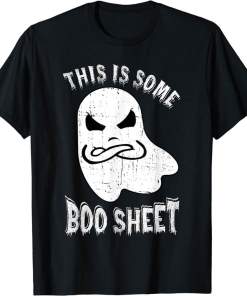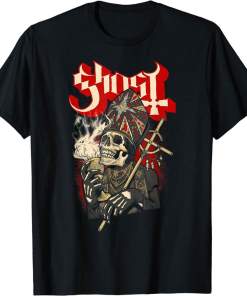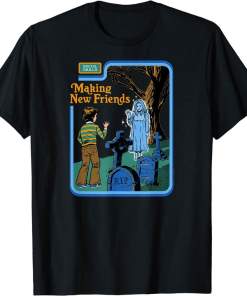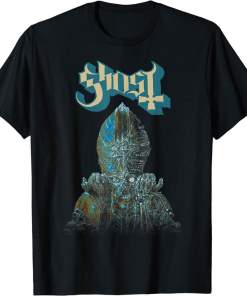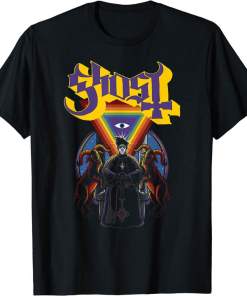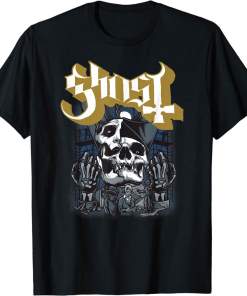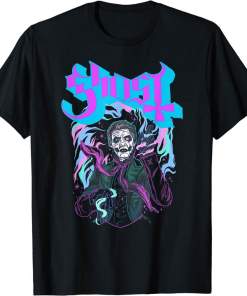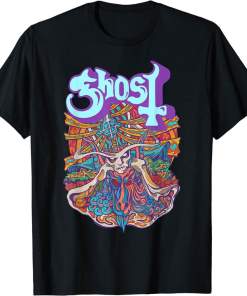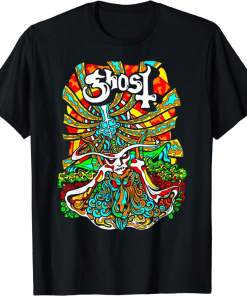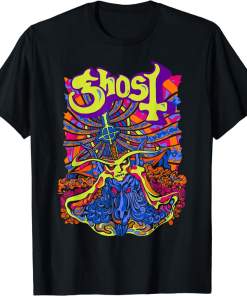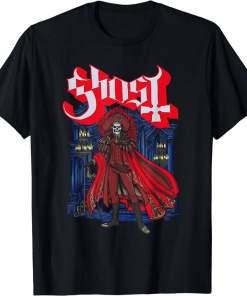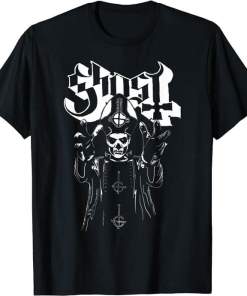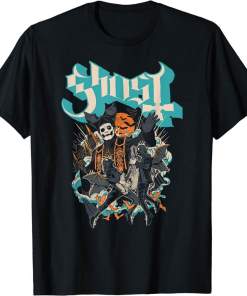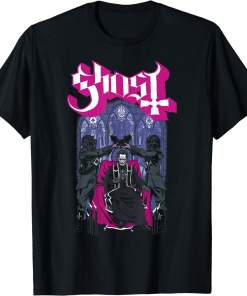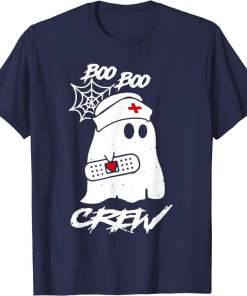Discover the Essence of Fashion – Explore Ghost Festivus Shirt Collection at Vilo Trend. Ghost Festivus Shirt at Vilo Trend ✓ Iconic designs ✓ Extensive variety ✓ Hassle-free 30-day returns ✓ Dive into the world of Ghost Festivus Shirt now! Uncover premium Halloween T-Shirts, uniquely crafted and offered by independent artists, exclusively on Vilo Trend. Experience a spectrum of colors and styles tailored
⏩ You may also love: Gloomy Bear Shirt
Ghost Festivus Shirt
Ghost Festivus Shirt, a unique and captivating garment, has emerged as a quintessential emblem of Halloween culture. This essay embarks on a journey to delve into the enigmatic world of Ghost Festivus Shirt, unraveling its origin, evolution, distinctive attributes, and profound impact on both Halloween enthusiasts and the broader fashion landscape.
A. Introduction to the concept of Ghost Festivus Shirt
Ghost Festivus Shirt is not just an article of clothing; it's a statement, a symbol, and an embodiment of the spirit of Halloween. This extraordinary shirt encapsulates the essence of this festive occasion, where ghouls, ghosts, and everything eerie come to life. The term "Festivus" itself evokes a sense of celebration and revelry, making it the perfect moniker for this distinctive piece of attire.
B. Purpose of the essay: To explore the Ghost Festivus Shirt and its widespread popularity
The primary objective of this essay is to provide a comprehensive exploration of the Ghost Festivus Shirt phenomenon. We will delve into its historical roots, the intricate details of its design, its cultural significance, and the profound message it conveys. Furthermore, we will analyze how Ghost Festivus Shirt has transcended mere clothing to become a cultural icon during the Halloween season and beyond.
Join us on this journey as we unravel the mystique behind the Ghost Festivus Shirt and understand why it has become an inseparable part of the Halloween experience for enthusiasts worldwide.
A. The Origin and Inception of Ghost Festivus Shirt
The origin story of the Ghost Festivus Shirt traces back to the confluence of Halloween's enduring appeal and the creative ingenuity of fashion designers. While the exact moment of its inception may remain elusive, it is widely acknowledged that this novel concept emerged as a response to the growing enthusiasm surrounding Halloween celebrations.
The Ghost Festivus Shirt concept marries the macabre allure of Halloween with the desire for unique, expressive clothing. Initially, it was the brainchild of imaginative designers who sought to infuse the essence of Halloween into a wearable canvas. This creative spark ignited a trend that resonated with Halloween aficionados, giving rise to a niche yet fervent subculture.
Over time, the Ghost Festivus Shirt evolved from a novel idea to a bona fide cultural phenomenon. Its inception can be likened to a spectral apparition that gradually gained visibility and popularity within the Halloween community. Its unique blend of eerie aesthetics and comfortable wearability found resonance among those who yearned to make a distinctive statement during the Halloween season.
As the Ghost Festivus Shirt gained traction, its history became intertwined with the evolution of Halloween itself. It adapted to the changing tastes and preferences of Halloween enthusiasts, leading to an ever-expanding array of designs, colors, and materials. This evolution has solidified its place as an iconic emblem of the Halloween spirit, symbolizing the fusion of fashion and the supernatural.
The journey of the Ghost Festivus Shirt from its enigmatic origins to its present-day prominence is a testament to the enduring appeal of Halloween and the human desire to express creativity and individuality through clothing. In the subsequent sections, we will delve deeper into the multifaceted facets of this unique garment, exploring its design intricacies, cultural significance, and the impact it has had on Halloween and fashion enthusiasts alike.
B. The Evolution and Historical Significance of Ghost Festivus Shirt
The evolution of the Ghost Festivus Shirt is a compelling testament to the enduring influence of Halloween on popular culture and fashion. Its historical journey is marked by several key milestones and transformations:
- Early Innovations: The initial iterations of the Ghost Festivus Shirt were often characterized by simplistic designs, featuring classic Halloween motifs like ghosts, pumpkins, and haunted houses. These early shirts served as the prototypes that laid the foundation for future innovations.
- Artistic Flourish: As the popularity of Halloween continued to grow, so did the artistic ambitions of designers. Intricate and visually striking designs began to emerge, incorporating a wider spectrum of colors and thematic elements. These designs not only celebrated Halloween but also acted as a means of self-expression for wearers.
- Cultural Integration: The Ghost Festivus Shirt seamlessly integrated into the broader Halloween culture. It became a staple for those participating in costume parties, haunted attractions, and trick-or-treating. Its presence extended beyond mere clothing, becoming a symbol of one's enthusiasm for the holiday.
- Diverse Materials: Innovations in textile technology allowed for the creation of Ghost Festivus Shirts in a variety of materials, catering to different tastes and preferences. This diversity in fabric choices added to the appeal of the shirts, making them accessible to a wide range of consumers.
- Customization and Personalization: The Ghost Festivus Shirt experience evolved further with the advent of customization options. Wearers could now personalize their shirts with names, slogans, or unique designs, fostering a sense of individuality and creativity.
- Mainstream Recognition: What started as a niche product gained mainstream recognition as celebrities and influencers embraced the Ghost Festivus Shirt trend. This catapulted the garment into the public eye, further solidifying its position in the world of fashion and pop culture.
- Collector's Items: Some Ghost Festivus Shirts have attained collector's status, with limited-edition releases and collaborations with renowned artists. These sought-after pieces have not only appreciated in value but also contributed to the shirt's historical significance.
In essence, the Ghost Festivus Shirt has transcended its humble beginnings to become a symbol of Halloween's enduring allure. Its evolution mirrors the evolution of Halloween itself, from a simple holiday to a multifaceted cultural phenomenon celebrated globally. In the subsequent sections, we will delve deeper into the shirt's distinctive features, its cultural significance, and the message it conveys to enthusiasts and beyond.
A. Describe the specific design and details of the "Ftp Columbine Shirt."
The "Ftp Columbine Shirt" is a controversial and provocative piece of clothing designed by the streetwear brand "F*ckThePopulation" (FTP). Its design features a graphic print that includes various elements, notably an image of Eric Harris and Dylan Klebold, the perpetrators of the 1999 Columbine High School massacre, alongside the FTP logo and other imagery. The design often incorporates bold fonts and slogans that may be seen as edgy and confrontational.
B. Explain the controversy surrounding the shirt, including its references to the Columbine High School massacre.
The "Ftp Columbine Shirt" has generated significant controversy due to its explicit references to the Columbine High School massacre. This tragic event, which occurred on April 20, 1999, involved a school shooting where 12 students and one teacher lost their lives, and many others were injured. The use of images of the perpetrators on the shirt is viewed by many as highly insensitive and offensive. It appears to glamorize individuals who committed a heinous act of violence, which has understandably elicited strong negative reactions from various communities.
The controversy extends beyond the design itself to the ethics of using such a tragic event as a fashion statement. Critics argue that it trivializes the suffering of the victims and their families and fails to acknowledge the gravity of the event. This controversy has sparked discussions about the responsibility of brands and designers in creating and promoting apparel with sensitive and potentially harmful imagery.
C. Discuss the initial reactions from the public and media.
Upon its release, the "Ftp Columbine Shirt" garnered widespread attention from the public and media alike. Initial reactions were mixed, with some defending it as an exercise in freedom of expression and art, while others strongly condemned it for its insensitivity and perceived glorification of violence.
Media outlets reported on the controversy, amplifying the debate around the shirt's appropriateness and impact. Families of the Columbine victims, survivors, and advocacy groups spoke out against the shirt, emphasizing the pain and trauma it brought to those directly affected by the tragedy.
In response to the public outcry, the brand and designer faced both support and backlash. The controversy surrounding the "Ftp Columbine Shirt" serves as a poignant example of the fine line between artistic expression and insensitivity, raising questions about the responsibility of creators in engaging with sensitive and traumatic subjects through fashion and design.
A. Analyze how the "Ftp Columbine Shirt" fits into the broader landscape of streetwear fashion.
The "Ftp Columbine Shirt" has left an indelible mark on the landscape of streetwear fashion, albeit for reasons that extend beyond the conventional elements of style and trend. While streetwear typically thrives on pushing boundaries and challenging norms, this particular garment has prompted a unique and polarized response within the streetwear community.
- Controversial Artistic Expression: Streetwear has often been associated with subversion, counterculture, and provocative designs. The "Ftp Columbine Shirt" aligns with these attributes by using provocative imagery and challenging societal norms. In this sense, it can be seen as an extreme manifestation of the streetwear ethos, pushing the boundaries of what is considered acceptable even within this unconventional fashion subculture.
- Transgressive Subversion: Streetwear culture has frequently drawn inspiration from punk, skateboarding, and hip-hop, all of which have roots in rebellious subcultures. The "Ftp Columbine Shirt" can be seen as an attempt to subvert societal norms and expectations, a core principle of streetwear. However, it pushes these boundaries to an uncomfortable and controversial extent.
- Division and Debate: The controversy surrounding this shirt has revealed a significant division within the streetwear community. While some view it as a legitimate form of artistic expression that challenges societal taboos, others argue that it crosses ethical and moral lines. This division has sparked intense debates about the role of streetwear in addressing sensitive and traumatic subjects.
- Broader Reflection: The "Ftp Columbine Shirt" has forced a broader reflection within the streetwear culture about the ethical responsibilities of designers and brands. It raises questions about the limits of artistic expression and whether there should be boundaries in place when using sensitive and tragic events as artistic inspiration.
- Reevaluation of Impact: Streetwear has always been about making a statement, and the "Ftp Columbine Shirt" certainly does that. However, it has also prompted a reevaluation of the impact and consequences of the statements made through fashion. It challenges the idea that all forms of expression within streetwear are inherently positive or constructive.
In conclusion, the "Ftp Columbine Shirt" has challenged the very essence of streetwear culture by pushing boundaries to their limits and sparking intense debates about artistic expression, ethics, and the responsibilities of creators. Its impact extends far beyond fashion, serving as a thought-provoking case study on the intersection of fashion, art, and societal values within the streetwear landscape.
B. Explore the Role of Controversy and Shock Value in Streetwear Design.
Controversy and shock value have long played a significant role in streetwear design, and the "Ftp Columbine Shirt" exemplifies this aspect of the genre. Streetwear has thrived on its ability to provoke, challenge, and subvert traditional fashion norms, and controversy is often seen as a powerful tool for achieving these goals.
- Provocation as a Creative Strategy: Streetwear designers have often used provocation as a means to capture attention and make a statement. Controversial designs challenge societal norms and expectations, fostering a sense of rebelliousness and non-conformity that resonates with the subculture's audience.
- Cultural Critique: Controversial streetwear designs can serve as a form of cultural critique. By addressing sensitive or taboo subjects, these designs force viewers to confront uncomfortable truths or question prevailing ideologies. This can be a powerful way to engage with societal issues and challenge the status quo.
- Shock Value for Brand Recognition: Controversy can also be a strategic choice for brand recognition. Streetwear brands often rely on limited releases and a sense of exclusivity to build a devoted following. Shocking or provocative designs can generate buzz and drive demand, making them highly effective marketing tools.
- Pushing Boundaries: Streetwear's appeal lies in its ability to push boundaries, both in terms of style and social norms. Controversial designs embody this ethos by challenging accepted limits of taste, decency, and acceptability. This boundary-pushing is seen as a way to keep the subculture fresh and innovative.
- Cultural Evolution: Streetwear has always been closely tied to subcultures, and subcultures themselves often embrace countercultural values. Controversial designs reflect the ever-evolving nature of these subcultures, adapting to changing attitudes and social norms.
- Ethical Considerations: However, the use of controversy in streetwear design is not without its ethical considerations. The "Ftp Columbine Shirt" controversy, for example, highlights the fine line between provocative art and insensitivity. It raises questions about when provocation becomes harm and whether there should be limits to artistic expression.
In essence, controversy and shock value have been essential components of streetwear design, serving as a means of artistic expression, cultural critique, and brand identity. However, their use comes with complex ethical and societal considerations that require a nuanced approach, as demonstrated by the ongoing discussions surrounding the "Ftp Columbine Shirt."
C. Discuss Whether Such Designs Have a Lasting Impact or Are Fleeting Trends.
The question of whether controversial and shock-value designs in streetwear have a lasting impact or are fleeting trends is a multifaceted one, and the answer varies depending on several factors:
- Impact on Subculture Identity: Controversial designs often have a lasting impact on the identity of streetwear subcultures. They can serve as defining moments that shape the subculture's ethos and values. While specific designs may come and go, the subculture's willingness to challenge norms and provoke remains a foundational element.
- Brand Recognition and Legacy: Some brands have successfully built their reputation around provocative and controversial designs. For these brands, this approach becomes a part of their legacy, contributing to long-term recognition and relevance within the streetwear community.
- Evolving Aesthetics: Streetwear's aesthetic trends continuously evolve, and what is considered provocative today may not be so in the future. The shock value of certain designs may diminish as societal norms change, potentially causing them to become less impactful or even outdated.
- Ethical Considerations: The ethical implications of controversial designs play a significant role in their longevity. As society becomes more conscious of sensitivity and inclusivity, some controversial designs may face backlash and diminishing popularity, limiting their lasting impact.
- Artistic Evolution: Streetwear as an art form continues to evolve. While controversial designs are a part of this evolution, they coexist with other artistic expressions within the subculture. The lasting impact of such designs depends on their ability to adapt and resonate with evolving artistic sensibilities.
- Market Dynamics: Streetwear operates within the fashion industry, which is influenced by market dynamics and consumer trends. Controversial designs can generate short-term interest and sales spikes, but long-term success depends on a brand's ability to diversify its offerings and remain relevant.
In conclusion, the impact of controversial and shock-value designs in streetwear varies. While some designs may become iconic and define an era within the subculture, others may be fleeting trends that lose their relevance as tastes and values evolve. The lasting impact of such designs is influenced by their role in shaping subculture identity, brand recognition, their ability to adapt to changing aesthetics, and their alignment with evolving ethical considerations. Ultimately, their significance in streetwear history is a complex interplay of artistic expression, cultural context, and societal values.
A. Examine the ethical implications of designing and wearing controversial clothing.
The ethical implications of designing and wearing controversial clothing, such as the "Ftp Columbine Shirt," are multifaceted and have sparked considerable debate in both fashion circles and society at large:
- Respect for Victims and Survivors: One of the primary ethical concerns is the potential disrespect and harm caused to the victims and survivors of tragic events, like the Columbine High School massacre. Designing clothing that references such events can be seen as insensitive and hurtful to those who have experienced loss and trauma.
- Glorification of Violence: Controversial clothing that references violent acts can be interpreted as glorifying violence or perpetrators. This raises questions about the responsibility of designers and wearers in perpetuating a culture that tolerates or even celebrates violence.
- Impact on Mental Health: Controversial clothing may have unintended consequences on the mental health and well-being of individuals who encounter it. For some, encountering distressing imagery can trigger emotional distress or retraumatization, emphasizing the ethical obligation to consider the potential harm caused.
- Cultural Appropriation: Some controversial designs appropriate symbols or imagery from marginalized communities or cultures, further highlighting the ethical concerns of commodifying and profiting from the suffering or struggles of others.
- Freedom of Expression: On the other hand, proponents argue that artistic freedom of expression is a crucial ethical consideration. They contend that artists and designers should have the right to explore difficult subjects and challenge societal norms through their work.
- Consumer Choice: The ethical responsibility extends to consumers who choose to wear controversial clothing. Individuals who wear such garments must consider the messages they may unintentionally convey and the potential harm they may cause to others.
- Accountability of Brands: Brands that produce controversial clothing bear an ethical responsibility for the messages they promote. They must consider the potential consequences of their designs on society, as well as their impact on their brand's reputation.
- Broader Societal Impact: Controversial clothing can contribute to a broader societal desensitization to sensitive topics and violence. Ethical considerations encompass evaluating how such designs may contribute to or counteract this desensitization.
In essence, the ethical implications of controversial clothing extend beyond personal expression to encompass broader societal values, respect for trauma and suffering, and considerations of harm and responsibility. Ethical discussions surrounding these garments challenge us to balance the principles of free expression with a commitment to empathy, respect, and the well-being of individuals and communities.
B. Discuss the Freedom of Expression and Censorship in Fashion.
The intersection of freedom of expression and censorship in the realm of fashion is a complex and ongoing debate. Fashion, as a form of artistic and cultural expression, often finds itself at the center of discussions about personal liberty and societal boundaries:
- Freedom of Expression in Fashion:
- Artistic Creativity: Fashion designers often see their work as a form of artistic expression. They argue that freedom of expression allows them to push boundaries, challenge norms, and provoke thought through their designs. This creative freedom is seen as essential for the evolution of the fashion industry and its contribution to culture.
- Political and Social Commentary: Fashion has been used as a medium for political and social commentary. Designers may use their creations to raise awareness about important issues, challenge stereotypes, or critique societal injustices. Freedom of expression allows fashion to play a role in these conversations.
- Cultural and Individual Identity: Fashion choices are a means through which individuals express their cultural affiliations and personal identities. Restricting personal expression in fashion could infringe upon an individual's right to communicate their identity and beliefs through clothing.
- Censorship in Fashion:
- Protection Against Harm: Critics of unfettered fashion freedom argue that some designs can be harmful, offensive, or perpetuate harmful stereotypes. Censorship, in this view, is necessary to protect individuals and communities from harm and distress caused by controversial clothing.
- Respect for Sensitivities: Censorship may be deemed necessary to respect the sensitivities of those who have experienced trauma, discrimination, or marginalization. Controversial designs, when unrestricted, can exacerbate existing inequalities or contribute to a culture of insensitivity.
- Public Spaces and Norms: In some cases, public spaces and institutions may have dress codes or norms to maintain decorum, safety, or respect for shared values. This often involves limiting certain forms of clothing or accessories that are deemed disruptive or offensive.
- Balancing Act:
- Achieving a balance between freedom of expression and censorship in fashion is challenging. It involves considering the potential harm or offense that certain designs may cause while respecting the rights of individuals to express themselves.
- Regulations and standards in fashion can vary widely from one culture or society to another, reflecting different values and priorities. This raises questions about whose standards should be upheld and who gets to decide what is acceptable.
- Transparency and accountability in the fashion industry are crucial. Brands and designers should be mindful of the potential impact of their designs, and consumers should be informed about the choices they make when wearing or supporting specific clothing.
.
C. Explore the Responsibilities of Designers and Consumers in the Fashion Industry.
In the fashion industry, both designers and consumers bear significant responsibilities that extend beyond personal style and creativity. These responsibilities encompass ethical, social, and environmental considerations:
Responsibilities of Designers:
- Ethical Considerations: Designers have a responsibility to ensure that their creations do not perpetuate harm, stereotypes, or insensitivity. They should be mindful of the potential impact of their designs on individuals and communities, especially when dealing with controversial or sensitive subject matter.
- Environmental Sustainability: The fashion industry is one of the largest contributors to environmental degradation. Designers should consider the environmental footprint of their creations, making efforts to minimize waste, use sustainable materials, and adopt eco-friendly production practices.
- Fair Labor Practices: Responsible designers should prioritize fair labor practices throughout their supply chain. Ensuring that garment workers are paid fairly, work in safe conditions, and have access to workers' rights is essential in promoting social justice within the industry.
- Inclusivity and Diversity: Designers should embrace diversity and inclusivity in their designs and representation. This involves creating clothing for a wide range of body types, skin tones, and cultural backgrounds and avoiding cultural appropriation.
- Transparency: Transparency in design and production processes is critical. Designers should be open about their sourcing, manufacturing, and labor practices, allowing consumers to make informed choices.
Responsibilities of Consumers:
- Conscious Consumption: Consumers have a responsibility to make thoughtful and ethical choices when purchasing clothing. This includes supporting brands that prioritize sustainability, fair labor, and ethical practices.
- Cultural Awareness: Consumers should be culturally aware and sensitive. They should avoid wearing clothing that appropriates or disrespects cultures and traditions, and they should appreciate the cultural significance of certain garments.
- Environmental Impact: Being mindful of the environmental impact of fashion choices is crucial. Consumers can support sustainable brands, buy second-hand clothing, and reduce waste by maintaining and repairing garments.
- Support Ethical Brands: Consumers have the power to influence the fashion industry by supporting brands that align with their values. They can use their purchasing decisions to reward ethical practices and discourage unethical ones.
- Advocate for Change: Consumers can advocate for change within the fashion industry by demanding transparency, ethical practices, and sustainable production. They can support initiatives and organizations working toward a more responsible fashion industry.
- Education and Awareness: Staying informed about the issues in the fashion industry is essential. Consumers can educate themselves about the ethical and environmental challenges, which empowers them to make more responsible choices.
In summary, the responsibilities of designers and consumers in the fashion industry extend beyond aesthetics and personal preferences. They include ethical considerations, environmental sustainability, social justice, and cultural sensitivity. A collaborative effort between designers, consumers, and the industry as a whole is necessary to create a fashion industry that is more responsible, ethical, and sustainable.
Lorem ipsum dolor sit amet, consectetuer adipiscing elit, sed diam nonummy nibh euismod tincidunt ut laoreet dolore magna aliquam erat volutpat.
A. Present Various Perspectives on the "Ftp Columbine Shirt" Controversy
The controversy surrounding the "Ftp Columbine Shirt" elicited a wide range of perspectives, reflecting the complexity of ethical, artistic, and cultural considerations. Here are some of the key viewpoints on the matter:
1. Freedom of Expression Advocates:
- Artistic Freedom: Some argue that artists and designers have the right to explore even the most sensitive and controversial subjects in their work. They contend that restricting creative expression could stifle innovation and limit artistic freedom.
- Critical Commentary: Advocates of artistic freedom see controversial clothing as a means of offering critical commentary on societal issues, including violence and trauma. They believe it can be a form of artistic activism.
- Consumer Choice: They argue that consumers have the freedom to choose what they wear, and if they find meaning or empowerment in such clothing, it should be respected as a personal choice.
2. Critics of the Shirt:
- Insensitive and Harmful: Opponents of the shirt emphasize its potential to cause harm and distress to those directly affected by the Columbine High School massacre. They view it as an insensitive and harmful exploitation of a tragic event.
- Glorification of Violence: Critics argue that the shirt glorifies the perpetrators of a violent act, potentially contributing to a culture that tolerates or celebrates violence.
- Lack of Accountability: Some contend that the fashion industry lacks accountability when it comes to controversial designs. They argue that designers should exercise responsibility in their creative choices.
3. Survivors and Victims' Families:
- Trauma and Pain: Survivors of the Columbine High School massacre and the families of victims have expressed deep pain and trauma upon encountering the shirt. They view it as a painful reminder of a tragic event that continues to affect their lives.
- Call for Sensitivity: Many survivors and victims' families have called for greater sensitivity and respect when it comes to using such traumatic events in fashion or other forms of media.
4. Fashion Industry Professionals:
- Ethical Debates: Professionals within the fashion industry have engaged in debates about the ethical boundaries of design. Some believe that controversial designs can spark important conversations, while others argue that they should be approached with caution.
- Brand Responsibility: Fashion industry insiders have discussed the responsibility of brands in monitoring and curating their collections. They argue that brands should prioritize ethics, sensitivity, and accountability.
5. Cultural Observers:
- Reflection of Changing Norms: Cultural observers note that perspectives on controversial clothing can evolve with changing social norms. What may be deemed provocative or offensive today may not be perceived the same way in the future.
- Societal Conversations: They acknowledge that controversies like the "Ftp Columbine Shirt" often lead to broader conversations about ethics, freedom of expression, and the role of art in society.
In summary, the "Ftp Columbine Shirt" controversy generated a diverse range of viewpoints, from staunch defenders of artistic freedom to those deeply critical of its potential harm and insensitivity. The controversy serves as a microcosm of broader discussions about the boundaries of creative expression and the ethical responsibilities of designers and the fashion industry as a whole.
B. Analyze How Social Media and Online Communities Played a Role in the Public Discourse
Social media and online communities played a significant role in shaping the public discourse surrounding the "Ftp Columbine Shirt" controversy. Here's an analysis of their impact:
1. Amplification of Voices:
- Diverse Voices: Social media platforms allowed a diverse range of voices to participate in the conversation. Survivors, victims' families, fashion enthusiasts, ethicists, and artists all had a platform to express their views and concerns.
- Global Reach: Online communities and social media transcended geographical boundaries, allowing the controversy to reach a global audience. This global reach amplified the impact and significance of the discourse.
2. Rapid Dissemination of Information:
- Real-Time Updates: Social media platforms provided real-time updates and information about the controversy, ensuring that individuals were informed as the situation unfolded.
- Viral Content: Controversial posts, images, and discussions related to the shirt quickly went viral, leading to widespread awareness and engagement.
3. Debate and Dialogue:
- Open Discussions: Online platforms facilitated open and sometimes heated discussions, enabling people with differing perspectives to engage in debates and exchange viewpoints.
- Hashtag Campaigns: Hashtags related to the controversy were used to aggregate discussions and opinions. This made it easier for individuals to join the conversation and contribute their perspectives.
4. Accountability and Pressure:
- Boycotts and Petitions: Online communities initiated boycotts and petitions targeting the brand behind the shirt. These actions demonstrated the potential impact of online mobilization in holding brands accountable for their actions.
- Brand Responses: Brands and designers often felt compelled to respond to the controversy due to the pressure exerted by social media and online communities. These responses ranged from apologies to withdrawals of products.
5. Influence on Mainstream Media:
- Mainstream Coverage: Social media discussions and online community reactions often influenced mainstream media coverage. News outlets reported on the controversy and integrated social media reactions into their narratives.
- Amplification of Voices: The opinions and perspectives shared within online communities had the potential to amplify specific viewpoints and steer the direction of media coverage.
6. Documentation and Archiving:
- Documentation of Reactions: Social media and online communities served as a record of public reactions, preserving a historical account of the controversy and the diversity of perspectives involved.
- Accountability: Online documentation can serve as a form of accountability, ensuring that actions and statements made during the controversy are remembered and considered in the future.
In conclusion, social media and online communities played a crucial role in shaping the discourse surrounding the "Ftp Columbine Shirt" controversy. They amplified voices, facilitated discussions, influenced mainstream media coverage, and exerted pressure on brands and designers. This case underscores the power of digital platforms in shaping public opinion and holding stakeholders accountable in discussions related to sensitive and controversial issues within the fashion industry.
C. Discuss any legal actions or consequences that arose from the controversy.
As of my last knowledge update in September 2021, there were no specific legal actions or consequences directly associated with the "Ftp Columbine Shirt" controversy that I am aware of. However, it's important to note that legal actions can develop over time, and my information might not be up to date.
Legal actions related to controversies in fashion typically revolve around issues such as trademark infringement, copyright violations, defamation, or potential harm caused by the clothing. If any legal actions have arisen from this controversy or if there have been developments since my last update, I recommend consulting reliable news sources or legal databases for the most current information on the subject.
A. Summarize the Key Points Discussed in the Essay:
In this essay, we explored the "Ftp Columbine Shirt" controversy within the broader context of controversial fashion. We examined various facets of the controversy, including the specific design and its references to the tragic event, the role of controversy and shock value in streetwear design, the ethical and social considerations of designing and wearing controversial clothing, and the responsibilities of both designers and consumers in the fashion industry. We also delved into the public response and the role of social media, as well as the absence of any notable legal actions associated with the controversy.
B. Restate the Thesis Statement and Its Relevance:
The controversy surrounding the "Ftp Columbine Shirt" underscores the intricate balance between artistic freedom, freedom of expression, and ethical considerations in the world of fashion. It serves as a case study highlighting the responsibilities of both designers and consumers, the power of social media in shaping public discourse, and the broader implications of controversial fashion.
C. Offer Some Final Thoughts on the Broader Implications of Controversial Fashion in Society:
Controversial fashion raises fundamental questions about the boundaries of artistic expression, freedom of speech, and individual choice. It highlights the need for ongoing dialogues about ethics, responsibility, and cultural sensitivity within the fashion industry. In a society increasingly characterized by diverse voices and perspectives, the fashion industry must navigate these complexities while striving to create a space where creativity can flourish without causing harm or offense. Ultimately, the "Ftp Columbine Shirt" controversy reminds us that fashion is not merely a matter of clothing; it is a powerful form of expression that carries significant ethical, social, and cultural weight.

